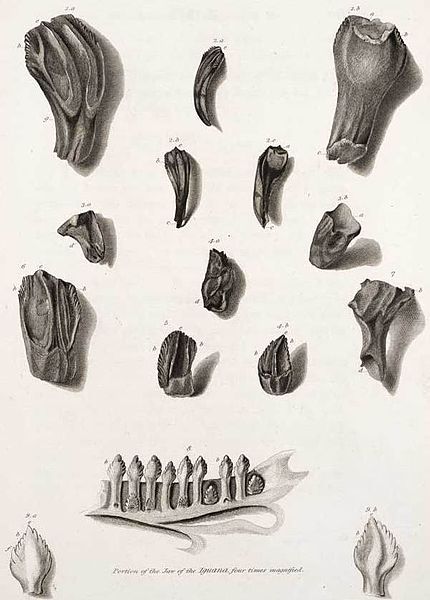Gideon Algernon Mantell MRCS FRS was an English obstetrician, geologist and palaeontologist. His attempts to reconstruct the structure and life of Iguanodon began the scientific study of dinosaurs: in 1822 he was responsible for the discovery of the first fossil teeth, and later much of the skeleton, of Iguanodon. Mantell's work on the Cretaceous of southern England was also important.
Gideon Mantell
166 High Street, Lewes, the home of Gideon Mantell
Sketch of Tilgate Quarry with Gideon Mantell overseeing the uncovering of fossils
Illustration of fossil Iguanodon teeth with a modern iguana jaw shown beneath them, from Mantell's 1825 paper describing Iguanodon.
Iguanodon, named in 1825, is a genus of iguanodontian dinosaur. While many species found worldwide have been classified in the genus Iguanodon, dating from the Late Jurassic to Early Cretaceous, taxonomic revision in the early 21st century has defined Iguanodon to be based on one well-substantiated species: I. bernissartensis, which lived during the Barremian to early Aptian ages of the Early Cretaceous in Belgium, Germany, England, and Spain, between about 126 and 122 million years ago. Iguanodon was a large, bulky herbivore, measuring up to 9–11 metres (30–36 ft) in length and 4.5 metric tons in body mass. Distinctive features include large thumb spikes, which were possibly used for defense against predators, combined with long prehensile fifth fingers able to forage for food.
Iguanodon
The original I. anglicus teeth from Mantell's 1825 paper
Mantell's "Iguanodon" restoration based on the Maidstone Mantellodon remains
Fossil iguanodont remains found in Maidstone in 1834, now classified as Mantellisaurus








